 |
|

|
 |
TABLE of CONTENTS
 |
MnDOT introduces 2017 construction projects, need for long-term funding bill |
By Mary McFarland Brooks
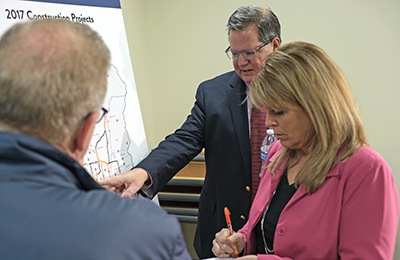
Tom OíKeefe, Metro District program delivery director, explains Twin Cities metro construction projects to John Croman, KARE 11, and Karen Scullin, KMSP Fox 9, during the Construction Kickoff news conference April 13. Photo by David Gonzalez |
Commissioner Charlie Zelle announced 211 statewide construction projects during a construction kickoff news conference April 13. The $1 billion construction season, which is well underway, will keep the state’s roads and bridges in good working condition, improve safety for motorists and support thousands of construction jobs across the state.
“While this year’s program is comparable in dollar value to last year’s, we are seeing fewer projects,” said Zelle. “And, in the coming years, we will also see the funding that is available to invest will decrease because of inflation and flattening revenue streams.”
The latest 20-year Minnesota highway investment plan forecasts an $18 billion dollar gap between anticipated revenue and what MnDOT will need to keep the transportation system operating competitively.

Crews install stainless steel reinforcing bar that will be part of the deck on the Rouchleau Pit bridge on the Hwy 53 relocation project. The concrete for the deck is scheduled to be poured in May and June. The new bridge will be open to traffic in November. Photo by Tom Lund |
“The transportation system is a key to Minnesota’s economic success,” Zelle said. “With more than half of our state roads older than 50 years, and 40 percent of our bridges more than 40 years old, the need is outpacing available resources. It’s important that legislators work together to find a long-term, sustainable funding solution this year so the transportation system does not continue to degrade.”
Zelle also announced 57 multimodal projects valued at $47 million. These include airport, port and railroad projects that are outside of the state road construction program.
2017 road and bridge construction season
Among the highlights of this year’s construction season is the anticipated completion of the St. Croix River Crossing between Stillwater, Minn., and St. Joseph, Wis., and the relocation of Hwy 53 in Virginia, Minn., that includes the construction of what will be the tallest bridge in Minnesota.
For a complete list of projects, including construction dates and traffic impacts, visit www.mndot.gov/construction. |
 |
|

|
 |
TABLE of CONTENTS
 |
District 6 donates snowplow to Riverland Community College |
By Mike Dougherty, District 6 public Affairs coordinator
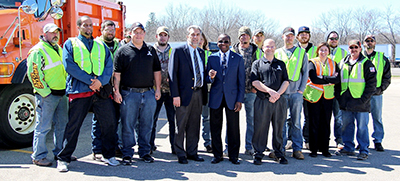
Riverland Community College President Adenuga Atewologun, center, holds the keys to the 2000 Sterling snowplow that MnDOT District 6 donated to the collegeís truck driving program. MnDOT District Engineer Jeff Vlaminck is directly left and Jonathan Rymer, the truck driving program director, is directly right of Atewologun. Students and staff of the program gathered for the photo by the snowplow. Photo courtesy of Riverland Community College |
A snowplow donation from MnDOT to Riverland Community College’s truck driving program is expected to aid students and the agency.
District 6 staff joined leaders of Riverland on the Austin campus April 6 in a ceremonial exchange of the keys for a snowplow. MnDOT was replacing the vehicle in its fleet and donated it to the Riverland truck driving program.
The snowplow equipment adds depth to a strong Riverland program that offers hands-on and classroom training for careers in the transportation industry. The equipment gives the students in the program additional exposure to equipment used in the field and provides them a greater range of experiences prior to seeking employment.
MnDOT, in turn, will work with Riverland to help students learn about careers at the agency as it continues to build a strong and diverse talent pool of employees.
“We see this as an opportunity for both of our organizations to benefit,” said Jeff Vlaminck, district engineer for District 6. “MnDOT is proud to be to partner with Riverland, because so much of our culture is about learning, training and improving. This is a strong connection to our mission.”
“One of Riverland’s key strategies has been to build strong partnerships with businesses, industries and agencies that employ our students,” said Adenuga Atewologun, Riverland college president. “We shape our training around the needs in our state and region. This donation and partnership is a prime example of two organizations working together to provide best in class training and better employment for students who graduate from our program.”
The 2000 Sterling snowplow was being replaced in MnDOT’s fleet as part of the normal replacement cycle. The manual transmission vehicle provides the truck driving students with a machine that’s still in good working order.
MnDOT puts some of its snowplows on the state auction or works on a transaction with other governmental bodies, such as townships that are seeking a snowplow. |
 |
|

|
|

|
 |
TABLE of CONTENTS
 |
MnDOT mourns death of former Commissioner Dick Braun |
|
By Rich Kemp
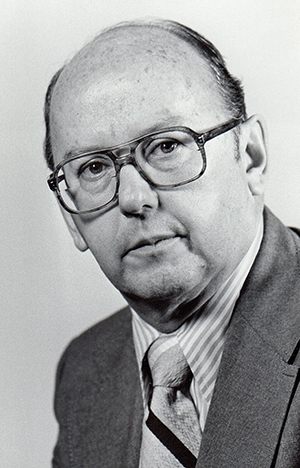
Dick Braun, MnDOT commissioner from 1979 to 1986, died April 11. File Photo |
Dick Braun, 91, former MnDOT commissioner and long-time transportation advocate, died April 11.
“Dick Braun is remembered at MnDOT for his innovation, professionalism and general concern for his employees and the traveling public,” said Commissioner Charlie Zelle. “He worked his way up through MnDOT and was a big part of its transformation to a multimodal agency. He left MnDOT to continue his work to improve transportation across the state with the Center for Transportation Studies and other ventures. He was a great man and an outstanding public servant.”
Braun joined the Minnesota Highway Department in 1948 after graduating from the University of Minnesota. He worked in five of the department’s districts, including as assistant district engineer in District 4 and deputy district engineer in the Metro District’s Golden Valley office.
In 1966 he was named assistant director of operations by Commissioner John Jamieson. He was appointed in 1968 by Commissioner Ted Waldor as assistant commissioner for Government and Community Relations.
He left the department in 1970 to work as the vice president and principal associate of the Twin Cities office of Barton-Aschman. While at Barton-Aschman, Braun worked with city and regional planning studies, urban renewal, traffic operations, area-wide transportation planning and developed bikeway programs in six states.
He returned as deputy commissioner of operations when MnDOT was formed in 1976 out of the former Department of Aeronautics and Department of Highways, and the transportation-related sections of the State Planning Agency and of the Public Service Department.
Gov. Al Quie appointed Braun as the MnDOT commissioner in 1979. As deputy commissioner and then as the commissioner, Braun helped lead the way to a multimodal agency.
Braun was re-appointed as commissioner when Rudy Perpich was elected governor in 1983.
“I served with then-MnDOT Commissioner Dick Braun in Gov. Rudy Perpich's administration,” said Gov. Mark Dayton. “He was one of the finest public servants I have ever known. He combined unsurpassed transportation expertise with impeccable integrity and genuine personal warmth. He led the Department of Transportation and served the people of Minnesota very, very well.”
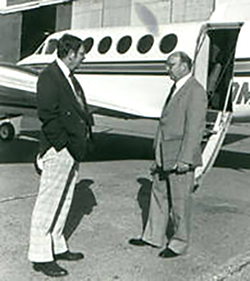
Former MnDOT Commissioner Dick Braun (right) talks to pilot Bill Grunau before a flight. File Photo |
Braun championed initiatives such as the Minnesota Road Research Project and Minnesota Rideshare. He served as president of the American Association of State Highway and Transportation Officials. Braun also served as chairman of the Metropolitan Airports Commission in the 1990s and as a member of the Columbia Heights school board.
Betsy Parker, chief counsel, worked in the Government Affairs and Right of Way offices when Braun was the commissioner.
“He had a good sense of humor, very down to earth,” said Parker. “He talked to everyone, cared about everyone. You always knew where you stood.”
Recent retiree George Thibault, who worked for more than 60 years with MnDOT and the State Highway Department, said he really enjoyed working for Braun.
“He worked for both republican and democratic governors, which is very unusual,” said Thibault. “He was respected by the staff at MnDOT and the Legislature.”
In 1986, Braun stepped down as commissioner to lead what is now the Center for Transportation Studies at the University of Minnesota. See CTS’s tribute to Braun.
Braun received more than 50 state, national and international awards for his work in transportation. He was recognized in 1990 as Minnesota’s Engineer for the Decade of the 80’s. In 2002, Braun was chosen as one of the top 10 public works leaders of the year by the American Public Works Association. The University of Minnesota Institute of Technology’s Department of Civil Engineering and the Center for Transportation Studies named a faculty chair position after him. The dual Hwy 610 bridges over the Mississippi River between Brooklyn Park and Coon Rapids are named the Richard P. Braun Bridge.
Braun is survived by his children, William, Jane and Catherine; brother Jack; and longtime companion, Phyllis Johnson. He is preceded in death by his wife, Ellen; siblings Virginia, Mary Lou and Thomas; and daughter, Barbara.
A celebration of life will take place June 18 at McNamara Alumni Center on the University of Minnesota campus. |
 |
|

|
 |
TABLE of CONTENTS
 |
Jody Martinson selected as new assistant commissioner for the Operations Division |
By Rich Kemp
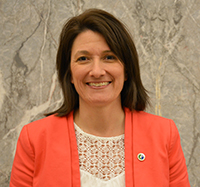
Jody Martinson is the new assistant commissioner of Operations. Photo by Rich Kemp |
Jody Martinson took over as the new assistant commissioner of Operations April 10. She served as the district engineer in District 4 since 2012.
“We’re excited to have Jody lead the Operations Division,” said Sue Mulvihill, deputy commissioner and chief engineer. “She brings a great deal of experience to the position and is a tremendous leader who is very strategic and focused on employees. I look forward to having her on the senior leadership team.”
Martinson replaces Mike Barnes, who retired from the agency in April. She has over 22 years in the transportation business. She started her career with MnDOT in June 1992 working as an engineering intern in District 4 for two summers. She became a graduate engineer for District 3, rotating through various offices and eventually became a project engineer in construction.
She was promoted to the District 3 Right of Way Engineer, before transferring to the Detroit Lakes office as the District 4 planner. Prior to being named district engineer, she served as the program development manager overseeing the Planning, Project Development, Right of Way and Surveys section.
“I place a lot of value in building relationships with our employees, communities and external partners,” said Martinson. “These connections are the key to our success at MnDOT.”
Martinson has a bachelor’s degree in civil engineering from North Dakota State University and is a licensed professional engineer.
“I am extremely proud of all the work we have accomplished in the Operations Division and am excited to keep our agency moving forward,” she said. |
 |
|

|
 |
TABLE of CONTENTS
 |
Competition for 'Best of WIG 2.0 sub WIGs' begins |
WIG champions and MnDOT leadership want to recognize those teams that have already achieved results and jumped into WIG 2.0 in full force. To acknowledge the hard work WIG 2.0 teams have accomplished, and results generated during WIG 2.0 so far, WIG coaches will soon have the opportunity to vote on the best of the WIG 2.0 sub-WIGs to date.
As of April 12, there were 78 completed sub-WIGs recorded in SharePoint. Sub-WIGs completed as of April 21 are eligible to be part of this friendly competition. To ensure your completed sub-WIG is entered, you will need to record your improvement results in the new “Page 2” of the sub-WIG Tracker.
Coaches will vote on the winning sub-WIGs based on the following simple criteria:
- Was the sub-WIG completed?
- Did the sub-WIG generate positive results?
- Was the sub-WIG high impact and innovative?
Submissions must be entered in the SharePoint sub-WIG Tracker Page 2 no later than Wednesday, May 3. |
 |
|

|
 |
TABLE of CONTENTS
 |
Agency updates records retention schedule |
By Rich Kemp

Charles Stech, assistant records manager, and Jennifer W. Witt, records and information manager, look over the records retention schedule. The bag on the table is the result of following the retention schedule. Many records are shredded when they are no longer needed. Photo by Rich Kemp |
The records management team has updated MnDOT’s records retention schedule, which serves as an inventory of the records produced by the agency. The schedule specifies how long to retain a records series and when/how, the records can be destroyed.
The team met with district and specialty offices to get their input before making changes to the retention schedule. As a result of this work (done in 2016), each office will have its own view of the retention schedule later this year that only pertains to their office.
It is MnDOT policy that all employees manage records and data in their care, which means the records and data are easily found, retrieved, secured, backed up and readable for the full retention period. Also, all records and data should be stored in MnDOT repositories or business applications, and not saved on a C: drive, removable drive, personal archives, personal email account, or a personally owned device.
The schedule was updated three years ago, but before that it hadn’t been updated in its entirety since 1989. The last two updates have decreased the types of records from 1,700 to 394 types.
“We traveled around to the districts and offices to determine how long items are kept and to get their input on what changes we should make,” said Jennifer W. Witt, records and information manager in the Office of Chief Counsel. “State statutes require MnDOT to keep all records necessary to document the agency’s official activities, but it’s important we don’t keep that information beyond the correct retention period or information that is redundant, obsolete or trivial.”
Some items have statutes that determine how long they are kept. For the rest, the records management team met with office and district records contacts, data domain stewards and subject area stewards to determine how long they should be kept.
“The new schedule had to be approved by MnDOT senior leaders, the Historical Society, Attorney General’s Office and the Office of the Legislative Auditor,” said Witt.
The new retention schedule went into effect March 17.
In the coming months, the records management team will meet with districts and offices to go over the new retention schedule.
Gov. Mark Dayton proclaimed April as records and information management month. The proclamation cites the importance of records management in controlling, maintaining and disposing of records for the well-being of the state.
Questions about the records management schedule should be directed to Witt or Charles Stech. |
 |
|

|
 |
TABLE of CONTENTS
 |
Whatís new on the web |
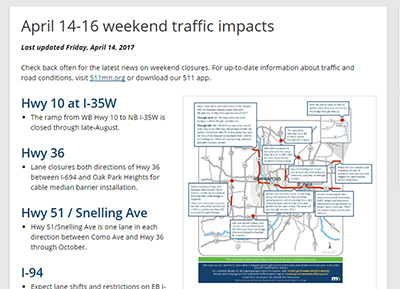
Weekend traffic impacts can be found on MnDOTís website beginning on Thursday. |
Weekend traffic impacts
Spring has sprung, and weekend traffic impacts are back. If you’re planning any weekend travel this construction season, check out an overview of significant weekend traffic impacts across the state before you head out. These maps show projects that could affect your weekend travel to help you plan ahead, and are typically updated every Thursday until construction winds down in the fall.
You can also visit www.511mn.org for up-to-date traffic and road conditions, and sign up for email updates on projects happening close to home or work.
Ombudsman annual report
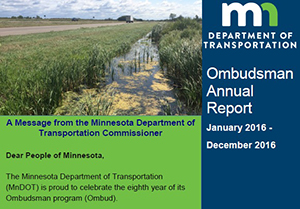
The Ombudsman annual report for 2016 is now available on MnDOTís website. |
The 2016 Ombudsman annual report is now available online. The report highlights customer feedback, case examples, statistics and developments regarding the Ombudsman program throughout the past year. Unique to this year’s report are narratives about rural rumble strip conflicts, LED light glare conflicts, and the formation of the Office of Public Engagement and Constituent Services.
New Library Materials posted on the web
New Library Materials are available at www.mndot.gov/library/newlibmat.html. Check this issue out if you are interested in submitting a research idea to the MnDOT Research Services for the next funding cycle, due May 18.
New Library Materials is a compilation of new titles and other resources added to the library collection during the previous month. To be added to the distribution list, contact pamela.m.gonzalez@state.mn.us or 651-366-3749.
Previous editions of New Library Materials are archived and available at www.dot.state.mn.us/library/recacq-archive.html. For other information requests, contact the Library at 651-366-3791 or e-mail library.dot@state.mn.us, or send requests via the Ask a Librarian web page. |
 |
|

|
 |
TABLE of CONTENTS
 |
On the Job: Chris Smith ensures that projects are compliant with plant, wildlife regulations |
By Dana Hernandez
Do you or a co-worker have an interesting job to share with readers? Send us your ideas, and we’ll contact you for more information.
Recent employee profiles:
|
 |
|

|
 |
TABLE of CONTENTS
 |
District 7 employees gather in North Mankato for 2017 Employee Day |
By Kristi Loobeek
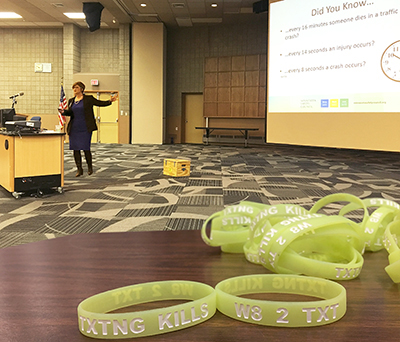
Lisa Kons, traffic safety program manager and Minnesota safety council coordinator, drives home safety messages at District 7ís Employee Day with highway camera footage, statistics and personal stories. Photo by Kristi Loobeek |
District 7 celebrated their Employee Day April 12 at South Central College in North Mankato. The theme of the day was “trends in transportation: then and now.”
A cheerful crowd from across the district started the morning with hallway displays showcasing local projects and programs.
Greg Ous, District 7 engineer kicked off the speaker portion of the day. Ous gleamed appreciation for his employees, both new and veteran. The district’s newest employee (mere days) and longest standing (30+ years) were recognized by Ous with a MnDOT t-shirt and a round of applause from peers.
Speakers covered topics from trends in traffic safety to trends in social media. |
 |
|

|
 |
TABLE of CONTENTS
 |
League of American Bicyclists awards Central Office, Detroit Lakes as bike friendly workplaces |
By Sue Roe
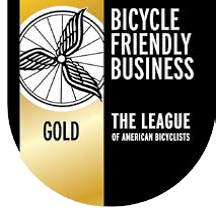
The League of American Bicyclists honors businesses for encouraging a more welcoming atmosphere for bicycling employees. |
The League of American Bicyclists named MnDOT’s Central Office and District 4 office in Detroit Lakes as bicycle friendly businesses. Central Office received a gold award and the District 4 Detroit Lakes office received a silver award.
The awards were given for efforts to encourage a more welcoming atmosphere for bicycling employees, customers and the community. The award statuses are good for four years and were given after MnDOT applied for the designation.
“MnDOT is proud to be a bicycle friendly business. More of our employees are bicycling to work every year,” said Tim Henkel, assistant commissioner in modal planning and program management. “We recognize the importance of embracing bicycling and other modes of commuting to make MnDOT an attractive place to work and an example for other employers.”
Supporting and encouraging bicycling for transportation is a part of MnDOT's vision where Minnesota’s multimodal transportation system maximizes the health of people, the environment and the economy.
To recognize the five new businesses named in the state this year, the League of American Bicyclists looked at several factors, including programs that encourage bicycle riding such as organized staff bicycle rides or bicycle clubs, bike infrastructure such as parking, shared bicycles and showers/locker rooms, bike education and bicycle ridership goals.
“I am so excited that MnDOT was recognized for its hard work to become more bike-friendly for its employees,” said Dorian Grilley, executive director of BikeMN. “They really see the big picture when it comes to the health and wellness benefits of active transportation options for staff.”
More than 1,200 businesses across the country have gained recognition at the bronze, silver, gold and platinum levels.
For more information, go to www.bikeleague.org. |
 |
|

|
 |
TABLE of CONTENTS
 |
MnDOT to raise awareness, inspire employees to reduce our impact to the environment |
By Commissioner Charlie Zelle
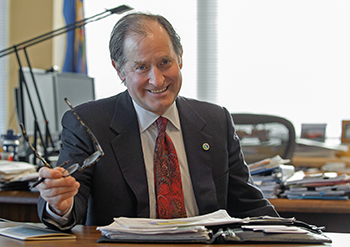
Commissioner Charlie Zelle discusses MnDOTís work to maximize the health of the environment. Photo by David Gonzalez |
MnDOT has a long history of collaborating with internal and external stakeholders to promote environmental stewardship. As people around the world celebrate Earth Week this week, and Earth Day on Saturday, April 22, I’d like to share with you some of the ways that MnDOT works to maximize the health of the environment. MnDOT employees ensure that projects comply with—or exceeds--local, state and federal environmental requirements.
Last year, MnDOT signed a Memo of Understanding with six states from Minnesota to Texas that designates Interstate 35 as the Monarch Highway. The monarch population has declined by 90 percent over the last 20 years, in part due to habitat loss. The six states agreed to work together to promote and enhance pollinator habitat along this corridor that follows the 3,000 mile annual migration of monarchs from Mexico to Minnesota.
MnDOT also works to protect threatened and endangered species, including the Northern Long-Eared Bat, who sometimes make their homes under bridges and overpasses, and the Rusty-Patched Bumble Bee, which may be found along MnDOT roadsides.

Commissioner Zelle drives one of MnDOTís electric vehicles that gets about 150 miles to the gallon. Photo by David Gonzalez |
MnDOT is working locally and nationally to promote electric vehicles. Since 2013, MnDOT has had three plug-in hybrid electric vehicles and has ordered a full electric Chevy Bolt that will arrive in June. MnDOT partnered with the MPCA, four other state Departments of Transportation and the City of Detroit, Michigan to designate Interstate 94, from Michigan to Minnesota, as the Great Lakes Zero Emission Corridor. The goal is to make interstate travel convenient for electric vehicle owners and to spur private investment in charging infrastructure. Emissions from transportation is the leading source of greenhouse gas emissions in the U.S. and second leading source in Minnesota. Lower emission electric vehicles are one way to reduce greenhouse gas emissions that also improves air quality.
MnDOT has a strong tradition of marking Earth Day with activities to raise awareness and inspire employees to continue to reduce our impact to the environment. And, we have done an outstanding job! MnDOT employees consistently contribute to energy savings, waste reduction, sustainable winter maintenance practices and resource conservation efforts. We know these efforts have a significant and positive impact.
I encourage you to try carpooling, using transit, or riding a bike to work, plant low maintenance trees and other vegetation in your yards, try using compost as a natural fertilizer, reduce the use of disposable coffee cups, food containers and silverware, fill up that reusable bottle and use “green driving” practices like reducing vehicle speed or minimizing aggressive driving.
Earth Day, and Earth Week, is a great opportunity for MnDOT employees to commit, individually and collectively, toward doing something to further MnDOT’s environmental stewardship and sustainability goals. If we all take some small actions we cumulatively contribute to a large and positive impact moving forward.
If you’re at Central Office on Thursday, April 20, I invite you to attend an Earth Day event, “Earth or Consequences” trivia game, sponsored by MnDOT’s Office of Environmental Stewardship and Senior Leadership. The event will be held from 11 a.m. to 1 p.m. on ground floor, outside the lunchroom. Test your environmental expertise by answering an earth friendly question to win a prize. |
 |
|
| |
|



